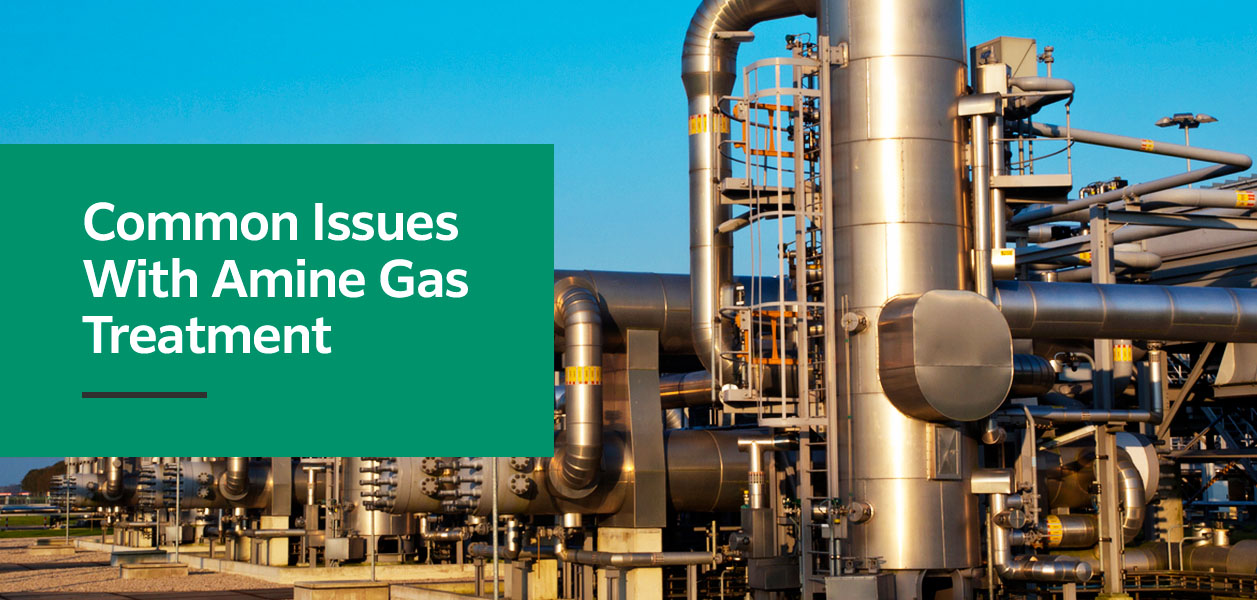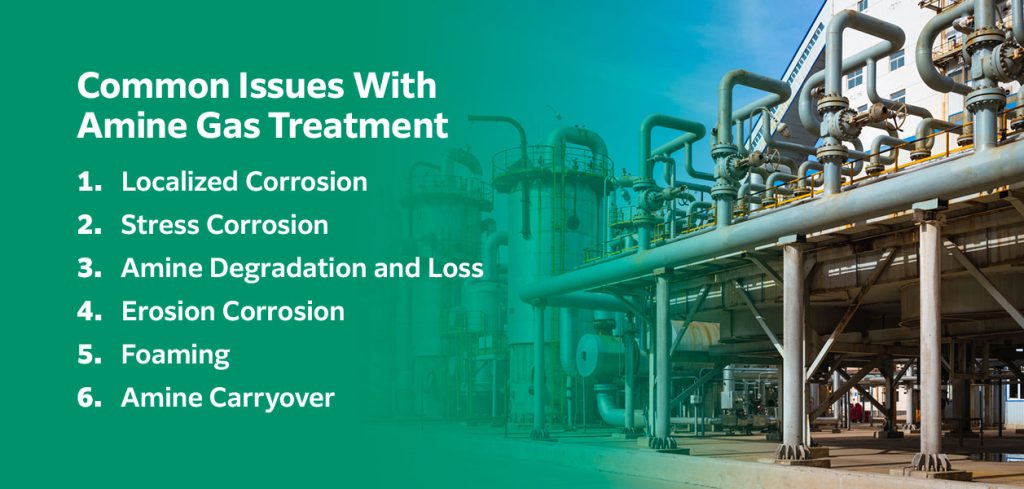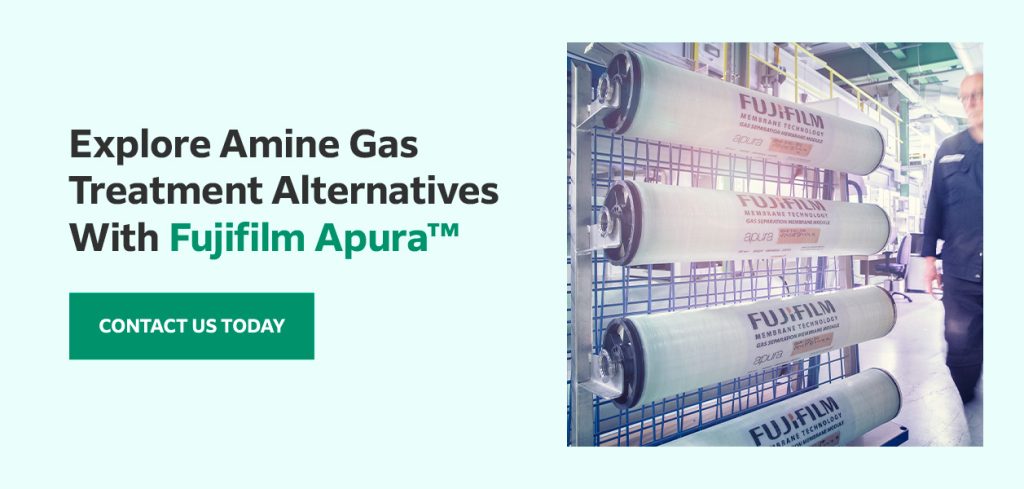
Jump to:
- What Is Amine Gas Treatment?
- Common Issues With Amine Gas Treatment
- Alternatives To Amine Gas Treatment
Corrosion in amine plants is a common challenge when sweetening natural gases. In addition, several other issues with amine gas treatment can lead to additional management and expense. Although amine gas treatment is a common practice, it requires care and skill to mitigate the associated challenges. Corrosion can cause extensive damage when left unchecked, resulting in unusable gases and costly repairs.
While there are benefits and drawbacks to every gas treatment method, there are alternatives to amine gas treatment that eliminate the extensive risks, providing oil companies with an environmentally friendly, easy-to-use option that’s well worth considering to avoid the labor and expense associated with corrosion stemming from amine gas treatment.
What Is Amine Gas Treatment?
Amine gas treatment is a process that removes undesirable components from natural gas, such as carbon dioxide (CO2) and hydrogen sulfide (H2S). The method uses amines — a compound derived from ammonia (NH3) containing nitrogen atoms with a lone pair. Gas with measurable amounts of CO2 and H2S is often referred to as “sour,” and amine gas treatment removes these components using chemical absorption to “sweeten” this natural gas and make it usable in many applications.
Amine systems comprise an absorber to remove CO2 and H2S from a sour gas stream and a regenerator for cleaning the amine. An amine gas treatment system commonly includes three processes — acid gas absorption, amine solution regeneration, and material separation and recovery.
There are many types of amine available, each suited to different applications. Selecting the correct amine is essential to minimize challenges. Even with the proper formula, though, and despite amine gas treatment having been an effective solution for sweetening natural gas for many years, the process comes with distinct difficulties.

Common Issues With Amine Gas Treatment
While amine gas treatment has high efficacy in specific applications, there are also several challenges to consider. Some of the disadvantages of amine gas treatment include the following:
1. Localized Corrosion
Amine gas treatment corrosion is a well-known challenge. Amine systems are complex, which makes them susceptible to corrosion in several ways. Localized corrosion occurs due to vapor flashing, when rich amine — or amine saturated with absorbed components — releases CO2 or H2S before reaching the regenerator.
The regenerator is where gas release is meant to occur — if it happens in other areas throughout the system, you may experience localized corrosion in the amine lines.
2. Stress Corrosion
Amine stress corrosion cracking — also known as amine cracking — is a form of alkaline stress corrosion that affects carbon and low-alloy steel. If there has been no post-weld heat treatment (PWHT), amine gas treatment can cause cracking in carbon steel piping. This type of corrosion damage is associated with lean amine. With rich amine, the process is known as wet H2S cracking.
Tensile stress levels include residual stress from welding, cold working or fabrication not correctly removed through PWHT. Amine concentration and temperature can also play a role. Amine cracking is typical in areas parallel to the weld in the adjacent base metal but can occur in weld deposit and heat-affected zones (HAZ) as well.
3. Amine Degradation and Loss
Virgin amine contains less than 1% of heat-stable salts, but they build up over time due to continuous recycling. In addition, replacing and storing amine is costly. Although various mechanisms are available to limit amine losses and degradation, the buildup of heat-stable salts can lead to corrosion on the lean amine circuits. Amine degradation can also occur due to high temperatures and contaminants in the system, particularly oxygen (O2).
4. Erosion Corrosion
Erosion corrosion removes iron sulfide and other elements that protect the piping equipment in amine gas treatment systems. High amine solution velocities and the impaction of gas and amine on metal surfaces can all cause erosion corrosion. Dirty amine solutions containing suspended solids can aggravate erosion corrosion, which affects several areas throughout the system.
5. Foaming
Amine contains hydrocarbon condensate, which can lead to foaming. Amine foaming leads to amine losses, requiring operators to add fresh amine to the system frequently. When foaming occurs in an amine system, its acid gas extraction efficiency is significantly reduced, requiring operators to minimize flow and inject flow inhibitors to manage the amine system effectively.
Introducing hydrocarbon liquids into the amine contactor often causes amine foaming. For the system to effectively remove CO2, it must operate at a specific temperature, and lower temperatures promote H2S removal efficiency. However, operators must balance temperatures effectively, as lower contactor temperatures increase the potential for liquid hydrocarbons to form in the inlet system. When this happens, foaming is more likely to occur.
6. Amine Carryover
Foaming in the amine system can lead to amine carryover, which causes poor gas-liquid contact in the amine absorber and abnormal tray flooding levels. The outcome is amine particulates carried over into the upflowing gas. Carryover can also be a result of equipment malfunction.
The presence of amine compounds in sweetened gas impacts the quality of the gas and, in some cases, renders it unsuitable for use. These compounds also contribute to system corrosion and make gas treatment systems less efficient.
Alternatives to Amine Gas Treatment
The amine-related issues described above can make the gas sweetening process expensive and time-consuming. However, other gas treatment methods are available that don’t come with the same challenges. Gas separation membranes are the most common alternative to amine gas treatment. These membranes are semipermeable and act as barriers, only allowing specific gases to cross.
Gas separation membranes have significant advantages, including energy efficiency and cost-effectiveness. They are simple to use, reducing the need for operators and extensive maintenance by skilled technicians. In addition, they are environmentally friendly and can lower your carbon footprint by up to 60%. Any process that reduces CO2 emissions and produces no toxins is valuable in modern business.

Explore Amine Gas Treatment Alternatives With Fujifilm Apura™
Choosing natural gas treatment processes involves significant consideration. Amine gas treatment is often effective but has considerable challenges — trust Fujifilm Apura™ for an effective alternative. We designed the Apura™ – 2.0 and Apura 1.5XF membranes specifically for natural gas sweetening, making it an excellent alternative to amine for natural gas treatment.
Our gas separation membranes are backed by an extensive background in organic chemistry. They are highly durable and able to operate in high temperatures, and the modular design makes integration into a hybrid system quick and straightforward. Whether you’re looking for cost-effective and reliable solutions for a new facility or want to upgrade your existing gas treatment processes, we can help you build an effective system suited to your needs.
Contact our experts for more information and start upgrading your gas treatment processes today.













